| |
Qi-gong practice usually changes the depth, frequency and rhythm of respiration in a conscious state. Breathing is a critical component in making the exercise effective and combining breathing with meditation helps reduce stress. The deepening of respiration expands lung capacity, promotes circulation of oxygen in the blood, massages the internal abdominal organs and helps the digestion and assimilation of food.
In a healthy adult, the normal respiratory rate is 12-18/min. Those who reach true proficiency in qi-gong will be able to achieve a finer, softer, even and deeper breathing. As a result, breathing frequency is obviously lower. In some cases, it will be at 1-2/min. The common breathing technique adopted are: |
 |
 |
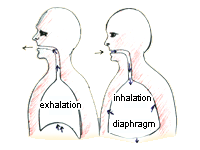 Natural breathing Natural breathing
An innate way of respiration without any control by the mind. It may be soft and even but not very deep. |
| |
 |
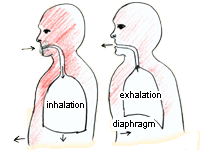 Abdominal diaphragmatic breathing Abdominal diaphragmatic breathing
Expand the abdomen and descent of the diaphragm while inhaling, and contract the abdomen while exhaling. This is the most common technique applied. |
| |
 |
Reversed abdominal diaphragmatic breathing
Contract the abdomen while inhaling, and expand while exhaling. |
| |
 |
Pausing-closing breathing
After inhalation or exhalation, the practitioner holds his breath for a short while to focus on the control of breathing. |
| |
 |
Nose-mouth breathing
Inhaling through the nose and exhaling through the mouth. |
| |
 |
Chant breathing
Chanting in the mind silently during respiration. |
| |
 |
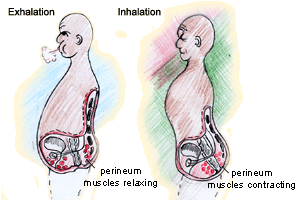 Breathing with holding anal muscles Breathing with holding anal muscles
Inhalation accompanied by contracting or with-holding the perineum muscles. Exhalation accompanied by relaxing the perineum muscles. |
| |
 |
Latent breathing
This is an advanced level for an abdominal breathing method. Due to consistent and intentional training of abdominal breathing, a practitioner will adopt a predominant abdominal respiration pattern when he enters a qi-gong state. A single breath takes a relatively long time. It is slow, gentle and even, without obvious sensation. |
| |
 |
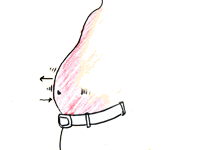 Genuine breathing Genuine breathing
This refers to very gentle abdominal breathing. The respiration seems to have stopped but actually still goes on, through the subtle pulsation in the abdomen. This is also called "fetal breathing", which is described as respiration through the navel. |
| |
 |
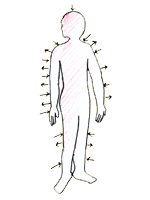 Opening and closing breathing Opening and closing breathing
A further advance on genuine breathing, this breathing technique is lead by consciousness. During respiration, imagine that the skin pores on the entire body are opening and closing simultaneously; they seem to be breathing too. A practitioner may feel tepid on the skin and sweat slightly. |